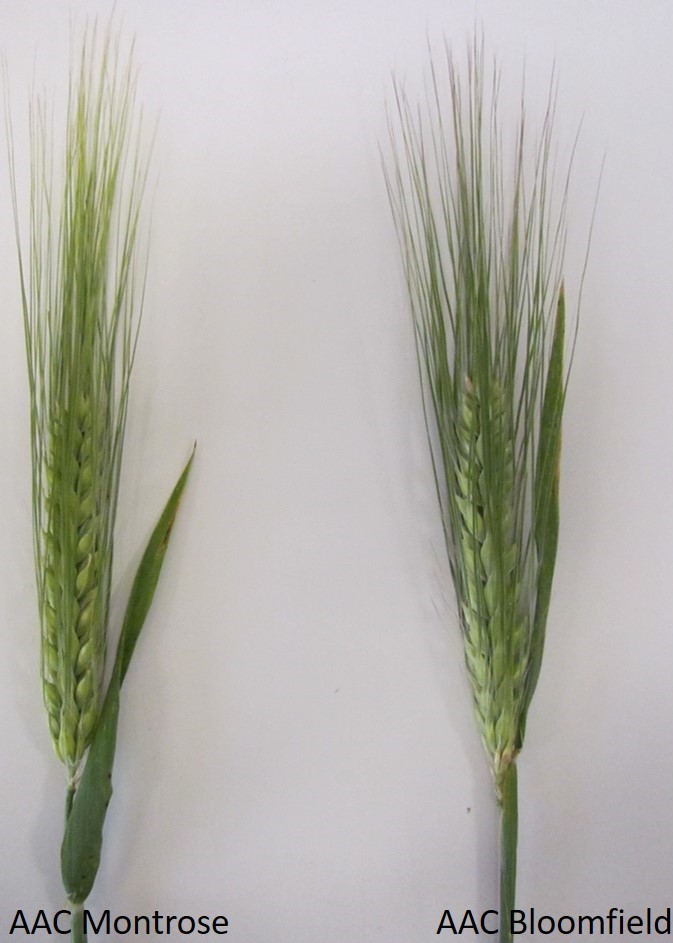AAC Bloomfield
| Denomination: | 'AAC Bloomfield' |
|---|---|
| Botanical Name: | Hordeum vulgare |
| Applicant/Holder: |
Agriculture & Agri-Food Canada, Ottawa Ottawa Research and Development Centre Room 1093A - 960 Carling Avenue Ottawa, Ontario K1A 0C6 Canada |
| Breeder: |
Thin-Meiw Choo, Agriculture & Agri-Food Canada, Ottawa, Ontario |
| Agent in Canada: |
Agriculture & Agri-Food Canada Office of Intellectual Property and Commercialization 107 Science Place Saskatoon, Saskatchewan S7N 0X2 Canada Tel: (306) 203-1383 |
| Application Date: | 2017-05-30 |
| Provisional Protection:: | 2017-05-30 |
| Application Number: | 17-9234 |
| Grant of Rights Date: | 2020-08-13 |
| Certificate Number: | 6241 |
| Grant of Rights Termination Date: | 2040-08-13 |
Variety Description
Variety used for comparison: 'AAC Montrose'
Summary: At booting, the frequency of plants with recurved flag leaves for 'AAC Bloomfield' is low whereas it is absent or very low for 'AAC Montrose'. 'AAC Bloomfield' has a weak intensity of anthocyanin colouration on the auricles of the flag leaf whereas the anthocyanin colouration is absent or very weak for 'AAC Montrose'. The intensity of anthocyanin colouration at the tips of the lemma awns of 'AAC Bloomfield' is strong whereas the anthocyanin colouration is absent or very weak at the tips of the lemma awns of 'AAC Montrose'. At the end of anthesis, the spike attitude of 'AAC Bloomfield' is semi-erect to horizontal whereas it is erect for 'AAC Montrose'. At the beginning of ripening, the spike of 'AAC Bloomfield' has a tapering shape whereas it is parallel sided for the spike of 'AAC Montrose'. Excluding the awns, the spike of 'AAC Bloomfield' is longer than that of 'AAC Montrose'. The spiculation on the margins of the lemma awns is rough for 'AAC Bloomfield' whereas it is smooth for 'AAC Montrose'.
Description:
YOUNG PLANT: erect growth habit at tillering, absent or very sparse pubescence on lower leaf sheaths
PLANT: two row, spring feed barley, spike emergence occurs mid-season
FLAG LEAF (AT BOOTING): low frequency of plants with recurved flag leaves, sparse pubescence on blade
FLAG LEAF SHEATH: strong to very strong glaucosity, sparse pubescence
AURICLES: weak intensity of anthocyanin colouration, sparse pubescence on margins
SPIKE: strong to very strong glaucosity, semi-erect to horizontal attitude, open and v-shaped collar, tapering shape, lax density, sterile spikelet absent, glume and awn of the median spikelet are longer than the grain
LEMMA AWNS: strong intensity of anthocyanin colouration of tips, longer than length of spike, rough spiculations on margins
FIRST SEGMENT OF RACHIS: long, strong curvature
KERNEL: whitish aleurone layer, short rachilla hairs, husk present, absent or very weak anthocyanin colouration of nerves of lemma, weak spiculation of inner lateral nerves of dorsal side of lemma, hairiness of ventral furrow absent, clasping disposition of lodicules, horseshoe shape of basal markings, short, medium width
AGRONOMIC CHARACTERISTICS: fair resistance to lodging, poor malting quality
DISEASE REACTION: susceptible to Fusarium Head Blight (Fusarium graminearum)
Origin & Breeding History: 'AAC Bloomfield' (experimental designations HS5617-11 and C2M17220) originated from the cross between OB5336-5 and OB5258-2 made in 2006 at the Agriculture and Agri-Food Canada Ottawa Research and Development Centre in Ottawa, Ontario, Canada. The F1 generation was grown in the greenhouse during the winter of 2006-2007. The plants were advanced using the bulk breeding method. The F2 to F4 generations were grown and bulked in Ottawa from 2007 to 2009. One hundred and eighty-four heads were selected for head types in the F4 generation and planted in hill plots (3 seeds per head per hill) in Brawley, California during the winter of 2009-2010. From the forty-five hills (or F5 lines) selected, twenty-six lines were entered into preliminary tests in Ottawa in 2011. The selection criteria included grain yield, lodging resistance and disease resistance. One of these F5 lines, designated as HS5617-11, was tested in the Ontario Six-Row Barley Screening Tests in 2012, the Ontario Six-Row Barley Orthogonal Trial in 2013-2014 and was also advanced to the Maritime Six-Row Barley Registration and Recommendation Tests in 2013 to 2015.
Tests & Trials: The comparative trials for 'AAC Bloomfield' were conducted during the 2017 and 2018 growing seasons at the Agriculture and Agri-Food Canada Ottawa Research and Development Centre in Ottawa, Ontario Canada. There were 4 replicates arranged in an RCB design with a planting density of 350 plants per metre square. In 2017, plots consisted of 4 rows with a row length of 3.6 metres spaced 0.22 metres apart with the plot measuring 4.45 square metres. In 2018, plots consisted of 6 rows with a row length of 3.7 metres spaced 0.17 metres apart with the plot measuring 4.07 square metres. Measured characteristics were based on 40 measurements per variety per year. Mean differences were significant at the 5% probability level based on a paired Student's t-test.
Comparison table for 'AAC Bloomfield' with reference variety 'AAC Montrose'
Spike length (excluding awns) (cm)
| 'AAC Bloomfield' | 'AAC Montrose' | |
|---|---|---|
| mean 2017 | 9.3 | 8.5 |
| std. deviation 2017 | 1.6 | 1.6 |
| mean 2018 | 9.0 | 8.3 |
| std. deviation 2018 | 0.9 | 1.1 |
Click on image for larger view

Barley: 'AAC Bloomfield' (right) with reference variety 'AAC Montrose' (left)
- Date modified: